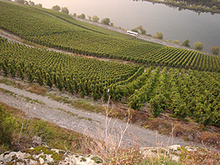Moselle wine

Moselle wine is produced in three countries along the river Moselle: France, Luxembourg (the Musel) and Germany (the Mosel). Moselle wines are mainly white and are made in some of the coldest climates used for commercial winemaking.
France
In France, in
Luxembourg
In southeastern Luxembourg, along the country's 42 km river border with Germany, 1 290 hectares of vines are used to produce wine under the designation
Sparkling wine (Crémant de Luxembourg) makes up a significant portion of the production, but is a designation within AC Moselle Luxembourgeoise rather than a separate appellation, which is usually the case with French Crémants.
Germany
Mosel is one of 13
References
- ^ ONIVINS: Nord-Est
- ^ "Vin de Moselle: The "Moselle" Country". Archived from the original on 2006-05-18. Retrieved 2007-09-09.
- ^ INAO: AOVDQS Moselle, updated until April 13, 1995
- ISBN 0-19-860990-6, p. 412-413: "Luxembourg"
- ^ Wine-Pages: Tom Stevenson on Luxembourg Archived 2007-09-30 at the Wayback Machine
